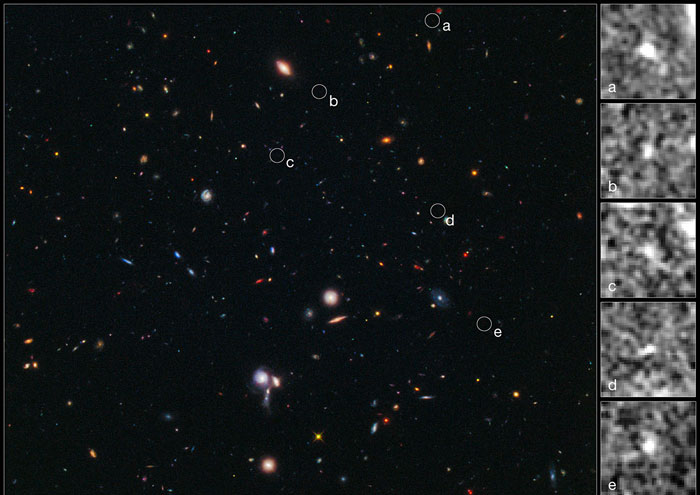Uncover unprecedented galaxy clusters
Using NASA's Hubble Space Telescope, astronomers discovered a cluster of galaxies while in its infancy. This is the most remote solar system galaxy ever observed, NASA said.
>>>Detecting large clusters of galaxies
In a near-infrared light survey, Hubble found five tiny galaxies lying close together, about 13.1 billion light-years away. They are among the brightest galaxies at a newly formed or very young age (only about 600 million years after the big bang explosion).

Round markers are tiny newly discovered galaxies.
Galactic clusters are considered to be the largest structures that exist in the universe, containing hundreds to thousands of galaxies, bound together by gravity. The image we see about the galaxy cluster Protocluster above is just Protocluster at 13 billion years ago. Most likely, it has evolved into one of the largest galactic clusters in the universe, equivalent to the nearby Virgo cluster of more than 2000 different galaxies.
'These galaxies form at the first stage of the universe, when galaxies are just beginning to get together,' said astronomer Michele Trenti of the University of Colorado on Space.com. 'This result confirms our understanding of the formation of galaxy clusters. And Hubble is strong enough to find the first examples at such a long distance. '
According to Space , finding new clusters of galaxies is difficult, because they are rare, fuzzy and often scattered throughout the sky. "We have to search in different areas, because the rate of finding such extremely rare signals is very small ," Trenti said. The search is an alternating series of successes. Usually, the result is only zero, but if they are lucky enough to find a clue, they can find many galaxies at once.
- Find the oldest cluster of galaxies
- Explore an amazing cluster of galaxies lurking in the Milky Way Galaxy
- 4 galaxy clusters collide 3 billion light-years from Earth
- Two clusters of galaxies contain hundreds of billions of stars about to collide
- The galaxy cluster has three million billion times the mass of the Sun.
- The early galaxy cluster is 12.4 billion light-years away from Earth
- The moment the two star clusters become one
- The magnetic field million light years in the universe
- Discovered 'carnivorous galaxies' in the star cluster of Heavenly Star
- Unprecedented discovery of supernovae
- Discovering cosmic dust clusters inside the Milky Way galaxy
- Close up of apocalyptic scenes of two world clusters
 Van Allen's belt and evidence that the Apollo 11 mission to the Moon was myth
Van Allen's belt and evidence that the Apollo 11 mission to the Moon was myth The levels of civilization in the universe (Kardashev scale)
The levels of civilization in the universe (Kardashev scale) Today Mars, the sun and the Earth are aligned
Today Mars, the sun and the Earth are aligned The Amazon owner announced a secret plan to build a space base for thousands of people
The Amazon owner announced a secret plan to build a space base for thousands of people